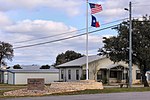Inks Dam
Buildings and structures in Burnet County, TexasBuildings and structures in Llano County, TexasDams completed in 1938Dams in TexasHydroelectric power plants in Texas ... and 3 more
Lower Colorado River Authority damsTexas building and structure stubsUnited States dam stubs

Inks Dam was constructed from 1936 to 1938 and forms Inks Lake, one of the seven Texas Highland Lakes. The lake and dam are owned and operated by the Lower Colorado River Authority for hydropower generation and recreational purposes and are named for Roy B. Inks, one of the original members on the LCRA Board of Directors. The Dam is also home to a national fish hatchery. Located just downriver from the spillway, Inks Dam NFH has 30 ponds ranging in size from 0.25 to 1.5 acres (0.10 to 0.61 ha) with a total of 28 acres (11 ha) for fish production. The facility also has an isolation building for endangered species containing aquariums of various sizes of circular tanks.
Excerpt from the Wikipedia article Inks Dam (License: CC BY-SA 3.0, Authors, Images).Inks Dam
Inks Dam Road,
Geographical coordinates (GPS) Address Nearby Places Show on map
Geographical coordinates (GPS)
| Latitude | Longitude |
|---|---|
| N 30.731111111111 ° | E -98.384722222222 ° |
Address
Inks Dam Road
Inks Dam Road
Texas, United States
Open on Google Maps









